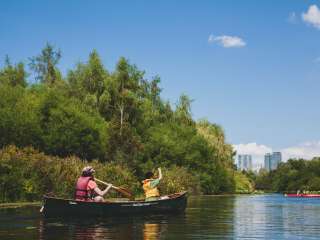Bellevue is a joy to visit all year long, but there’s something special about summer — when the breeze wafts in off Lake Washington, Mount Rainier towers over the southern horizon, and a steady diet of sunshine pervades the five-day forecast.
With the nice weather comes some of the year’s best hiking opportunities. And around Bellevue, the options are limited only by the length of your vacation. Some of our most popular trails lead to sun-kissed overlooks, head through forests teeming with wildlife, and pass colorful gardens in the heart of the city. So as you make plans to visit Bellevue this summer, here’s a list of some not-to-miss hikes to add to your to-do list.
Changing Forests & Sweeping Viewpoints on Display at Poo Poo Point
The charmingly named Poo Poo Point Trail offers far more than a silly moniker; over the course of about 7.2 miles (round-trip), hikers enjoy a mix of urban and rural sites unlike anywhere else in the Bellevue area.
A pair of trails start near Issaquah High School before ascending through a forest of Douglas fir, maple, and cedar; remarkably, this thick forest is actually fairly new, as loggers worked on West Tiger Mountain well into the 1970s. As the old roadbed and railroad grade ascends, hikers pass knee-high ferns, salmonberry bushes (in summer), and occasional wildflower blooms (such as the three-petal white trillium) in spring.
Eventually, after climbing about 1,750 feet, hikers arrive at a clearing near the summit, where a tubular windsock flies atop a flagpole, denoting Poo Poo Point itself. Home to a few picnic tables, this is a natural spot for a scenic lunch or a snack — a few Cascade peaks can be seen, as can nearby mountains and (on a clear day) the top of Seattle’s downtown skyline. The lack of trees here makes the point a popular launch point for local paragliders, adding to the viewpoint’s allure.
About that name: Loggers in the early 1900s worked on the slopes of West Tiger Mountain, and they named Poo Poo Point as a reference to the sound of a steam whistle.
Public Parks at the Heart of the Lake to Lake Trail & Greenway
The Puget Sound region is synonymous with its many bodies of water, and the Lake to Lake Trail and Greenway — which can top 20 miles (round-trip) but is easily customizable for hikers of all skill levels — showcases two of Bellevue’s most beloved lakes, as well as its numerous urban parks.
Broadly speaking, the greenway forms a sideways "Y" shape, with two western endpoints alongside Lake Washington; those are near Meydenbauer Bay Park and at Enatai Beach Park (in the shadow of the East Channel Bridge). At the greenway's easternmost point, meanwhile, hikers can choose between a pair of trailheads in the 90-acre Weowna Park near the shore of Lake Sammamish. (Of course, hikers can also start from parks throughout the greenway and put together a trip suited to their time constraints, comfort, interests, and experience levels.)
In between the primary trailheads, the well-signed path stitches together a trail through some of the city’s most popular green spaces — including the wetlands of the Lake Hills Greenbelt, the leafy Wilburton Hill Park, and the peaceful Mercer Slough Nature Park. Keep an eye out in these parks for beavers, deer, great blue herons, and other wildlife. Note that surfaces vary and may include dirt trails, the occasional sidewalk, and asphalt paths.
Explore a Waterfall & Regional History on Coal Creek Falls Loop
The Coal Creek Falls trail doesn't just showcase a scenic waterfall in the midst of a lush forest; it offers a glimpse into the region's past — back when coal was king and Bellevue was an industrial boomtown.
Taken together, Coal Creek Natural Area hosts nearly 4.5 miles of hiking trails roughly 20 minutes southeast of downtown. The loop to the falls covers about 2.5 miles (round-trip) and 416 feet of elevation gain amid forests of fir, maple, alder, and cedar. This area hosted a bustling coal mine between the mid-1800s and mid-1960s, producing millions of tons of coal and decimating the beauty of the surrounding hillsides. Relics and artifacts still line the paths today, as do interpretive panels that explain their uses and historical importance.
Mother Nature has reclaimed the land, and the modern-day loop trail courses through a verdant canopy while occasionally following Coal Creek and heading through thick undergrowth that includes ferns and springtime wildflower displays. Eventually, the trail ends at the 28-foot Coal Creek Falls, surrounded by stately cedar trees. The waterfall is fed by winter runoff, so it reaches its thundering peak between March and May; Coal Creek Falls occasionally runs dry in late summer, so try to visit by early July to enjoy the most dramatic sights. There are several paths in this area — so be sure to bring a trail map or bring up turn-by-turn directions before setting out.
Pacific Northwest Flora Shines at the Bellevue Botanical Garden in Wilburton Hill Park
It's easy to see why Wilburton Hill Park is a favorite among local and visiting families alike: The 120-acre park, just 1.5 miles east of downtown Bellevue, hosts ballfields, a children’s playground, freestanding exercise equipment, and about 3.5 miles of (mostly gravel) hiking trails that pass a variety of scenic gardens.
Along those trails, one of the park's undeniable highlights is the 53-acre Bellevue Botanical Garden, made up of several smaller gardens that showcase a wide range of flora. Rhododendrons come alive in vibrant blooms of pink and purple in early summer, the Waterwise Garden shows off plants that don't require much water to grow, and the dazzling Dahlia Display blooms between July and early October. Of course, several easy trails link the gardens and connect to the wider Wilburton Hill Park, making it easy to customize a hike to your liking.
Take in the beauty of the Bellevue Botanical Garden as Bellevue Ambassador Rashad Little pays a visit to some of the garden’s highlights, accompanied by a member of the garden staff to lead the way and provide additional insights.
As an added bonus, Kelsey Creek Park is almost directly across the street. The family-friendly park hosts additional hiking trails, as well as barns and farm animals that can be viewed between 9 a.m. and 3 p.m. daily.








